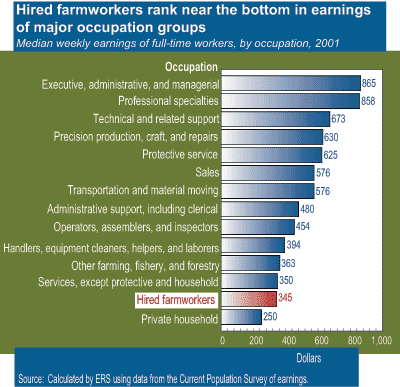The Dynamics of Hired Farm Labor
- by Jack L. Runyan
- 6/1/2003
Since World War II, the number of farmworkers has significantly declined as technology has advanced. Yet, hired farmworkers as a share of the total agricultural workforce—which includes farm operators and unpaid workers—have increased since the 1940s and accounted, on average, for over one-third of agricultural employment in the 1990s, up from one-quarter in the 1950s.
Less than 1 percent of all U.S. wage and salary workers, hired farmworkers make a significant contribution to agricultural output, providing labor during critical production periods. Hired farmworkers include those who reported their primary employment as farm managers (10 percent), supervisors of farmworkers (5 percent), nursery workers (3 percent), and farmworkers engaged in planting, cultivating, and harvesting crops or tending to livestock (82 percent). The number of hired farmworkers varies significantly throughout the U.S. The West accounted for over 44 percent of all hired farmworkers in 2000, and the West and South together accounted for almost 75 percent of hired farmworkers. The Northeast had the smallest number of workers (7 percent). Over half of all hired farmworkers (460,000) were located in five States—California (30 percent), Texas (10 percent), Florida (6 percent), New York (4 percent), and North Carolina (3 percent).
In 2001, over 80 percent of hired farmworkers were male, nearly 46 percent Hispanic, and nearly 75 percent less than 45 years old. Over half had not finished 12 years of school, and over a third were not U.S. citizens. By contrast, slightly more than 50 percent of all wage and salary workers were male in 2001, over 70 percent White, and over 60 percent younger than 45. More than half had 13 or more years of school, and more than 90 percent were U.S. citizens.
With median weekly earnings of $345 in 2001, hired farmworkers are some of the lowest paid full-time workers in the U.S. Several factors contribute to their poor economic situation: low wages, seasonal employment, weak attachment to the labor force, and limited participation in the nonfarm labor market. Most receive few benefits and work long hours in jobs that are sometimes unsafe. Some farm labor experts suggest that as many as half of hired farmworkers are in this country illegally. Their ability to secure better jobs in agriculture or elsewhere in the economy is often hindered by immigration policy, cultural differences that may impede their integration into the broader society, lack of access to education and other training to enhance skills, and other barriers. Long-term concerns surrounding the farm workforce, such as low economic returns to work, poor working conditions, and occupational safety issues, have been further complicated by a greater reliance on immigrant labor.
This article is drawn from:
- Farm Labor. (n.d.). U.S. Department of Agriculture, Economic Research Service.
- Hired Farmworkers’ Earnings Increased in 2001 But Still Trail Most Occupations. (2002). Economic Research Service. in Rural America Vol 17 No. 3..


